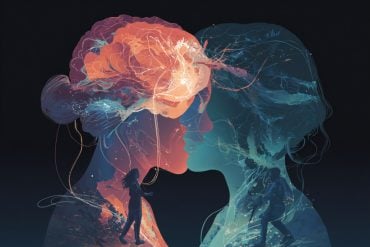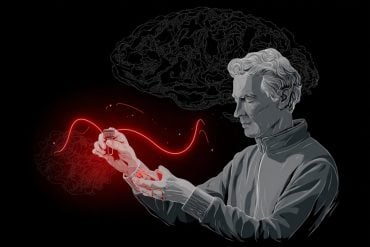Summary: Researchers have uncovered what they are calling ‘neurological synergy’ which occurs during visual adaptation.
Source: NYU.
A team of scientists has uncovered a neurological synergy that occurs in visual adaptation, a phenomenon in which perception is altered by prolonged exposure to a stimulus.
Well-known examples include the “motion aftereffect” and “facial expression aftereffect.” In the former, staring at a moving stimulus–for example, a waterfall–and then shifting gaze to a steady object–such as a nearby rock–causes an illusion in which the “steady” object (the rock) appears to move in the opposite direction. In the facial expression adaptation, after viewing a face with a beaming smile, faces with a neutral expression appear sad, while viewing a sad face causes a neutral face to appear happy.

The findings of the new study, which appear in the Journal of Vision, challenge a common assumption that adaptation aftereffects are purely sensory. By quantifying the relationship between altered sensory responses and how we act on it, the scientists determined that adaptation could change how sensory neurons respond to stimuli as well as how we decide based on these altered responses.
“We come across optical illusions in our daily lives, but how our behavior is shaped by them is not well understood,” explains Roozbeh Kiani, an assistant professor in NYU’s Center for Neural Science and the study’s senior author. “Our findings show two separate processes function in a synergistic fashion.”
Adaptation aftereffects may be a manifestation of a normative and beneficial process.
“The nervous system uses adaptation to adjust the range of stimuli it is most sensitive to,” adds Jonathan Winawer, another senior author and an assistant professor of psychology at NYU. “Prolonged exposure to a stimulus usually means a higher chance of observing similar stimuli. Our decision-making adjusts to this expectation, amplifying behavioral effects of changes in sensory neurons.”
These adjustments increase our ability to discriminate the most expected stimuli while also reducing our reaction times. However, they can also cause aftereffect illusions for stimuli dissimilar to the adaptor.
The study’s other authors included Nathan Witthoft, a researcher at NYU and Stanford University, and Long Sha, an NYU doctoral student.
To quantify the role of the decision-making system in adaptation, the researchers focused on facial expression aftereffect. Human participants viewed facial images of a single person whose expressions spanned from happy to sad, then reported the expression. The scientists compared participants’ choices and reaction times against predictions of decision-making models. The combination of choice and reaction times showed that in addition to sensory changes, adaptation also affected the decision-making process itself.
Funding: This work was supported by a National Institutes of Health grant (R00 EY022116, R01-MH109180), an NIH National Research Service Award training grant (R90-1R90DA043849), a Simons Collaboration on the Global Brain grant (542997), and a McKnight Scholars Award.
Source: James Devitt – NYU
Publisher: Organized by NeuroscienceNews.com.
Image Source: NeuroscienceNews.com image is credited to Nim Tottenham.
Original Research: Open access research for “Sensory and decision-making processes underlying perceptual adaptation” by Nathan Witthoft; Long Sha; Jonathan Winawer; and Roozbeh Kiani in Journal of Vision. Published August 2018.
doi:10.1167/18.8.10
[cbtabs][cbtab title=”MLA”]NYU”A Neurological Synergy in Explaining the Processing of Optical Illusions.” NeuroscienceNews. NeuroscienceNews, 4 September 2018.
<https://neurosciencenews.com/optical-illusion-synergy-9795/>.[/cbtab][cbtab title=”APA”]NYU(2018, September 4). A Neurological Synergy in Explaining the Processing of Optical Illusions. NeuroscienceNews. Retrieved September 4 2018 from https://neurosciencenews.com/optical-illusion-synergy-9795/[/cbtab][cbtab title=”Chicago”]NYU”A Neurological Synergy in Explaining the Processing of Optical Illusions.” https://neurosciencenews.com/optical-illusion-synergy-9795/ (accessed September 4 2018).[/cbtab][/cbtabs]
Abstract
Sensory and decision-making processes underlying perceptual adaptation
Perceptual systems adapt to their inputs. As a result, prolonged exposure to particular stimuli alters judgments about subsequent stimuli. This phenomenon is commonly assumed to be sensory in origin. Changes in the decision-making process, however, may also be a component of adaptation. Here, we quantify sensory and decision-making contributions to adaptation in a facial expression paradigm. As expected, exposure to happy or sad expressions shifts the psychometric function toward the adaptor. More surprisingly, response times show both an overall decline and an asymmetry, with faster responses opposite the adapting category, implicating a substantial change in the decision-making process. Specifically, we infer that sensory changes from adaptation are accompanied by changes in how much sensory information is accumulated for the two choices. We speculate that adaptation influences implicit expectations about the stimuli one will encounter, causing modifications in the decision-making process as part of a normative response to a change in context.






